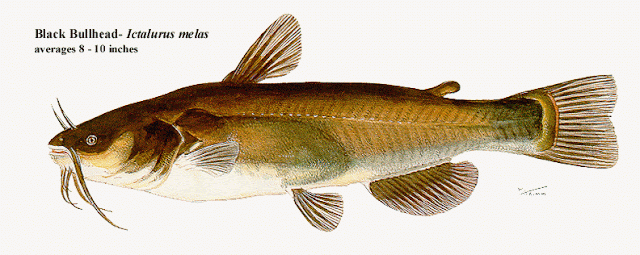Fishing Bullhead, Black .
Distribution. The black bullhead is found from southern Ontario west to Saskatchewan and through-out the Great Lakes, the Hudson Bay, the St.Lawrence, and the Missis-sippi River basins, extending to New York in the east, the Gulf of Mexico in the south, and Montana in the west.Introduced populations exist in Arizona, California, and other states.
Habitat. Black bullhead inhabit pools, backwaters,and slow-moving sections of creeks and small to large rivers; they also inhabit impoundments, oxbows,and ponds. They have a preference for muddy water and soft mud bottoms and are able to tolerate polluted water better than other catfish do. They prefer water in the 75° to 85°F range and tend to avoid cooler, clearer water.
A smaller member of the catfish family, the black bullhead is very popular due primarily to its fine culinary appeal. It is often stocked in farm ponds and raised commercially.
Identification. Although the name would imply some-thing else, the “black” bullhead may actually be yellowish green, dark green, olive, brown, or black on the back;bronze or green on the sides; and bright yellow or white on the belly. The entire body possesses a lustrous sheen. Only the young and spawning males are truly black.
Distinguishing the black bullhead from the brown or the yellow bullhead can be done by noting the rear edge of the pectoral fin in the latter two, which have a spine that is ser-rated with numerous sharp, thorny protrusions; those found on the spine of the black bullhead’s pectoral fin are much less prominent and may be absent altogether. The black bullhead has dark chin barbels that may be black-spotted, a chubby body, and a squarish tail.
Size/Age. Black bullhead reportedly grow to 241⁄2 inches in length, but they are most common at 6 to 7 inches and are seldom larger than 2 pounds. The maximum life span for black bullhead is approximately 10 years, although most live only 5 years. The world record is 7 pounds, 7 ounces.
Spawning behavior. Spawning takes place in May, June,and July, usually at water temperatures between 66° and 70°F. In weedy sections, the female clears away debris and silt to prepare the nest. Spawning up to five times an hour,the female releases roughly 200 eggs each time, fanning the eggs in-between spawning. Both parents fan the eggs until these hatch, and they guard the fry, which leave the nest in compact schools.
Food and feeding habits. Adults forage primarily at night, feeding on clams, snails, plant material, and fish.

Awesome fish info. Fish identification is something we all could see a lot more of on the net.
RăspundețiȘtergerevery interesant blog
RăspundețiȘtergere